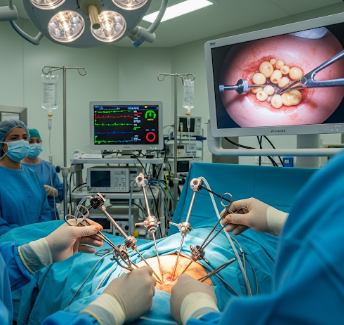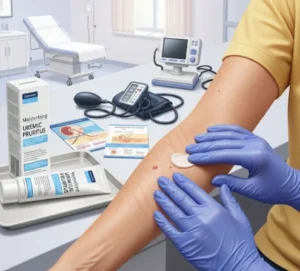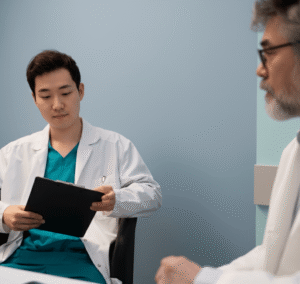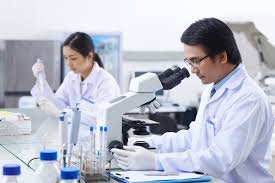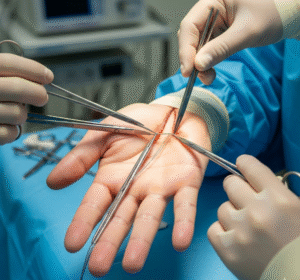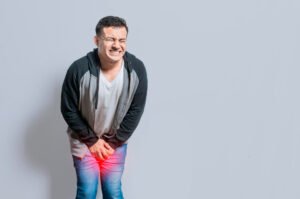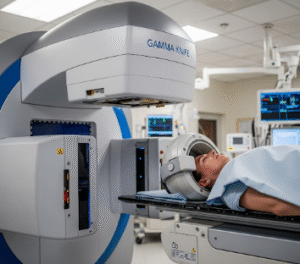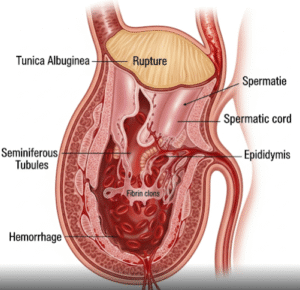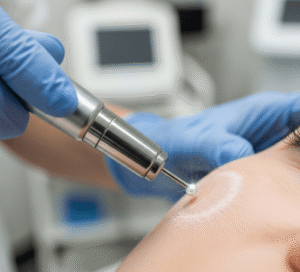Overview
Surgery for diverticular disease is a medical procedure performed to treat complications arising from diverticulosis or diverticulitis, such as recurrent infections, bleeding, perforation, or obstruction of the colon. Diverticular disease involves small pouches (diverticula) forming in the colon wall, which can become inflamed or infected.
In Korea, this surgery is performed in advanced colorectal centers using minimally invasive laparoscopic or robotic techniques, ensuring effective management, minimal complications, and faster recovery.
What is Surgery for Diverticular Disease?
The surgical procedure is designed to remove the affected segment of the colon and restore bowel continuity.
Common surgical approaches include:
- ✦ Laparoscopic colectomy: minimally invasive removal of the diseased colon segment.
- ➤ Robotic-assisted colectomy: precise dissection and suturing using robotic instruments.
- ✦ Open colectomy: traditional approach in complex or emergency cases.
- ➤ Primary anastomosis or stoma creation: reconnecting the healthy colon ends or creating a temporary/permanent colostomy, depending on patient condition.
The main goal is to eliminate infection, prevent recurrence, and restore normal bowel function.
What are the Benefits?
Surgery for diverticular disease provides several advantages:
✅ Treats severe or complicated diverticulitis that is unresponsive to medical therapy.
➤ Prevents recurrent infections, perforation, or bleeding.
✦ Minimally invasive options reduce postoperative pain and hospital stay.
➤ Restores normal bowel function and quality of life.
✅ Low recurrence rates when the diseased colon segment is properly removed.
✦ Emergency management of perforation or obstruction.
Procedure Details
1) How should I prepare for Surgery for Diverticular Disease?
Preparation steps include:
- ✦ Medical evaluation: review of medical history, medications, allergies, and previous abdominal surgeries.
- ➤ Diagnostic imaging: CT scan, colonoscopy, or MRI to identify disease extent and complications.
- ✦ Laboratory tests: complete blood count, electrolytes, kidney and liver function tests.
- ➤ Bowel preparation: laxatives or enemas as instructed to empty the colon.
- ✦ Medication adjustments: stop anticoagulants or medications affecting healing as advised.
- ➤ Consent and counseling: discussion of procedure type, risks, benefits, and recovery expectations.
2) What happens during the procedure Surgery for Diverticular Disease?
The procedure is performed under general anesthesia:
➤ Step 1: Patient is positioned supine, and the surgical area is sterilized.
✦ Step 2: Laparoscopic ports or open incision is made depending on the approach.
➤ Step 3: Diseased segment of the colon is carefully identified and dissected.
✦ Step 4: Blood vessels supplying the affected segment are ligated.
➤ Step 5: The affected colon is removed, and healthy ends are reconnected (primary anastomosis) or a temporary/permanent stoma is created if needed.
✦ Step 6: Incisions are closed, sterile dressing applied, and patient is monitored in recovery.
Minimally invasive techniques in Korea reduce tissue trauma, lower infection risk, and allow faster return to daily activities.
3) What happens after Surgery for Diverticular Disease?
Postoperative care includes:
- ✦ Monitoring: vital signs, abdominal examination, and early detection of complications.
- ➤ Pain management: oral or IV analgesics as prescribed.
- ✦ Diet progression: start with liquids, advance to soft foods, and eventually normal diet as tolerated.
- ➤ Wound care: keeping incisions clean and dry, observing for infection.
- ✦ Activity guidance: early ambulation to prevent blood clots and promote bowel function.
- ➤ Follow-up: outpatient visits for wound assessment, stoma care if present, and overall recovery.
Recovery typically takes 2–6 weeks depending on the surgical approach and patient condition.
Risks / Benefits
Potential Risks:
- ✦ Infection at the surgical site or internally.
- ➤ Bleeding or hematoma formation.
- ✦ Anastomotic leak if colon ends do not heal properly.
- ➤ Bowel obstruction or adhesions post-surgery.
- ✦ Rare injury to nearby organs (bladder, ureter, or small intestine).
Benefits:
- ✅ Eliminates diseased colon segment, reducing recurrence risk.
- ✅ Resolves complications such as infection, bleeding, or perforation.
- ✅ Minimally invasive techniques shorten hospital stay and reduce pain.
- ✅ Restores bowel function and quality of life.
- ✅ Effective management in both elective and emergency scenarios.
Recovery and Outlook
Recovery after diverticular surgery generally includes:
- ➤ Hospital stay: 2–7 days for minimally invasive surgery; longer for open surgery or complications.
- ✦ Pain management: controlled with medications.
- ➤ Diet progression: liquids to solids over several days.
- ✦ Gradual activity resumption: light walking immediately; full activity after 4–6 weeks.
- ➤ Long-term outcome: majority of patients experience resolution of symptoms, restored bowel function, and low recurrence.
When To Call the Doctor
Contact your healthcare provider if you notice:
⚠ Severe abdominal pain or distension.
⚠ Fever, chills, or signs of infection.
⚠ Persistent vomiting or inability to pass gas/stool.
⚠ Unusual bleeding from rectum or stoma.
⚠ Worsening or recurrent symptoms after surgery.
Best Korea Option / Process
Korea provides world-class surgery for diverticular disease with:
- ✦ Expert colorectal surgeons skilled in laparoscopic, robotic, and open approaches.
- ➤ Advanced imaging and diagnostic tools for precise surgical planning.
- ✦ Minimally invasive and outpatient options for suitable patients.
- ➤ Comprehensive pre- and post-operative care including pain management, diet counseling, and rehabilitation.
- ✦ Safe and effective procedures for both international and domestic patients.
- ➤ Multidisciplinary support including nursing, nutritionists, and physiotherapy to optimize recovery.
Korea ensures patients receive safe, precise, and effective treatment for diverticular disease with minimal complications and excellent long-term outcomes.
Highlights of Surgery for Diverticular Disease in Korea
- ✅ Minimally invasive laparoscopic and robotic options.
- ➤ Effective management of acute and chronic complications.
- ✦ Reduced hospital stay and faster recovery.
- ➤ Restoration of normal bowel function.
- ✅ Comprehensive care and follow-up for optimal outcomes.

